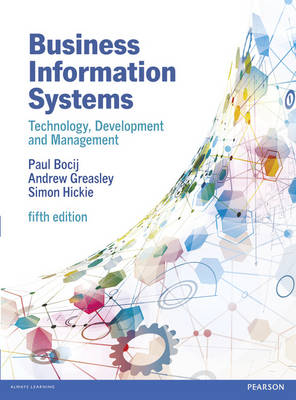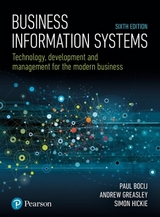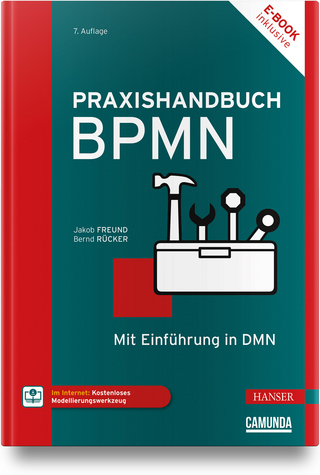
Business Information Systems, 5th edn
Pearson Education Limited (Verlag)
978-0-273-73645-5 (ISBN)
- Titel erscheint in neuer Auflage
- Artikel merken
understanding the technology of business information systems;
choosing the right information system for an organisation;
developing and managing an efficient business information system;
employing information systems strategically to achieve organisational goals.
Taking a problem-solving approach, Business Information Systems looks at information systems theory within the context of the most recent business and technological advances. This thoroughly revised new edition has updated and expanded coverage of contemporary key topics such as:
Web 2.0
enterprise systems
implementation and design of IS strategy
outsourcing
Business Information Systems does not assume any prior knowledge of IS or ICT, and new concepts are simply defined. New business examples, case studies and web links are fully integrated throughout, illustrating the relevance and impact of information systems in today’s business environment. In addition there are a wealth of questions and exercises both in the book and online at www.pearsoned.co.uk/bis enabling students to test their understanding of key topics and issues.
This book is ideal for students on any courses related to business information systems or management information systems at undergraduate or postgraduate level.
About the authors
Andrew Greasley lectures in Information Systems, Operations Management and Simulation Modelling at Aston Business School, Aston University.
Paul Bocij is a Senior Teaching Fellow at Aston Business School. An experienced educator, he has worked for a wide variety of institutions, including universities, colleges and numerous commercial organisations. His commercial experience includes time spent in the fields of programming, management, training and consultancy.
Simon Hickie has worked for 20 years as a senior lecturer in business information systems, having previously worked for 10 years in the management information systems field in a variety of roles including progammer, project manager and trainer. His particular interests lie in the areas of information systems in SMEs, change management and strategic information systems management.
Andrew Greasley lectures in Information Systems, Operations Management and Simulation Modelling at Aston Business School, Aston University. Paul Bocij is a Senior Teaching Fellow at Aston Business School. An experienced educator, he has worked for a wide variety of institutions, including universities, colleges and numerous commercial organisations. His commercial experience includes time spent in the fields of programming, management, training and consultancy. Simon Hickie has worked for 20 years as a senior lecturer in business information systems, having previously worked for 10 years in the management information systems field in a variety of roles including progammer, project manager and trainer. His particular interests lie in the areas of information systems in SMEs, change management and strategic information systems management.
Preface
Guided tour
Plan of the book
About the authors
Acknowledgements
Publisher’s acknowledgements
Part 1 INTRODUCTION TO BUSINESS INFORMATION SYSTEMS
1 Basic concepts – understanding information
Links to other chapters
Learning outcomes / Management issues
Introduction
Data and information
Creating information
Qualities of information
Case study 1.1: Technology sponsors a complementary form of capitalism
The business environment
Managerial decision making
Case study 1.2: Dealing with the data deluge
Focus on knowledge management
Summary
Exercises
References / Further reading / Web links
2 Basic concepts – an introduction to business information systems
Links to other chapters
Learning outcomes / Management issues
Introduction
Introduction to systems
Different types of systems
Business information systems
Resources that support BIS
Categories of business information system
E-business systems
Enterprise systems
BIS and strategic advantage
Case study 2.1: PayPal eyes in-store retail customers
Mini case study: Capital One develops information leadership
Case study 2.2: Corporate IT falling short of potential
Summary
Exercises
References / Further reading / Web links
3 Hardware and software
Links to other chapters
Learning outcomes / Management issues
Introduction
Components of a computer system
Major categories of computers
Types of microcomputers
Input devices
Case study 3.1: Mainframes are thriving in a cloud world
Mini case study: Optical mark recognition
Case study 3.2: Hertz reaps virtualisation rewards
Case study 3.3: Business life – Rise of the paperless meeting
Case study 3.4: Cloud is silver lining for German online bank Fidor
Output devices
Focus on printers
Storage devices
Processors
Categories of software
Document production software
Graphics packages
Spreadsheets
Management applications of productivity software
Multimedia software
Software for using the Internet
Focus on software distribution models
Summary
Exercises
References / Further reading / Web links
4 Databases and business intelligence
Links to other chapters
Learning outcomes / Management issues
Introduction
Databases
Business intelligence
Data warehouses
Case study 4.1: Big data put under the spotlight as never before
Case study 4.2: Making business intelligence work
Business analytics
Case study 4.3: After 160 years, the value of maps is starting to be appreciated
Mini case study: How to get rid of ‘devil customers’
Mini case study: Using GIS to identify road traffic accident locations
<
| Erscheint lt. Verlag | 18.12.2014 |
|---|---|
| Verlagsort | Harlow |
| Sprache | englisch |
| Maße | 194 x 264 mm |
| Gewicht | 1626 g |
| Themenwelt | Mathematik / Informatik ► Mathematik ► Finanz- / Wirtschaftsmathematik |
| Wirtschaft ► Betriebswirtschaft / Management ► Marketing / Vertrieb | |
| ISBN-10 | 0-273-73645-0 / 0273736450 |
| ISBN-13 | 978-0-273-73645-5 / 9780273736455 |
| Zustand | Neuware |
| Informationen gemäß Produktsicherheitsverordnung (GPSR) | |
| Haben Sie eine Frage zum Produkt? |
aus dem Bereich



